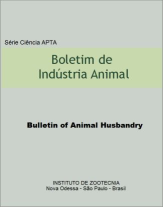Agronomic behavior of annual ryegrass (Lolium multiflorum lam.) in Rio Grande do Sul State
DOI:
https://doi.org/10.17523/bia.v73n3p198Keywords:
winter forage, improvement, selection.Abstract
The objective of this study was to evaluate forage production and number of days to flowering in 15 common ryegrass populations, one population of the KLM 138 (Uruguay) and Fepagro São Gabriel cultivars, and one local population in order to select germplasm with production potential. A randomized block design consisting of three replicates and repeated measures over time (cuts) was adopted. Forage production was evaluated by cutting samples of 2 linear meters per plot. The forage samples of each plot were dried and weighed for the determination of total dry matter. A total dry matter subsample of each plot, in each cut, was used to estimate leaf percentage. The data were submitted to analysis of variance using mixed models and means were compared by the Tukey test (P<0.05). A fourth replicate (block) using all populations was not submitted to cutting and was used to estimate the number of days to flowering. Flowering was defined when more than 50% of the plants of the plots had inflorescences. Except for the first cut, no difference in total dry matter production was observed (P>0.05), indicating little variability for this trait in the populations studied during the growth cycle. The populations differed significantly in terms of leaf dry matter percentage (P=0.0002). The highest leaf percentages during the growth cycle were observed for cultivar KLM 138. However, populations of the common Uruguayan, Dom Pedrito and Vacaria cultivars also exhibited good leaf production and may be used for initial selection of new promising materials, considering that a higher percentage of leaves promotes better quality feed offered to animals. The variation in the number of days to flowering permits selection for different maturation cycles of common ryegrass.Downloads
Downloads
Published
Issue
Section
License
Os autores não serão remunerados pela publicação de trabalhos, pois devem abrir mão de seus direitos autorais em favor deste periódico. Por outro lado, os autores ficam autorizados a publicar seus artigos, simultaneamente, em repositórios da instituição de sua origem, desde que citada a fonte da publicação original seja Boletim de Indústria Animal. A revista se reserva o direito de efetuar, nos originais, alterações de ordem normativa, ortográfica e gramatical, com vistas a manter o padrão culto da língua e a credibilidade do veículo. Respeitará, no entanto, o estilo de escrever dos autores. Alterações, correções ou sugestões de ordem conceitual serão encaminhadas aos autores, quando necessário. Nesses casos, os artigos, depois de adequados, deverão ser submetidos a nova apreciação. As opiniões emitidas pelos autores dos artigos são de sua exclusiva responsabilidade. Todo o conteúdo deste periódico, exceto onde está identificado, está licenciado sob a Licença Creative Commons Attribution (CC-BY-NC). A condição BY implica que os licenciados podem copiar, distribuir, exibir e executar a obra e fazer trabalhos derivados com base em que só se dão o autor ou licenciante os créditos na forma especificada por estes. A cláusula NC significa que os licenciados podem copiar, distribuir, exibir e executar a obra e fazer trabalhos derivados com base apenas para fins não comerciais.













